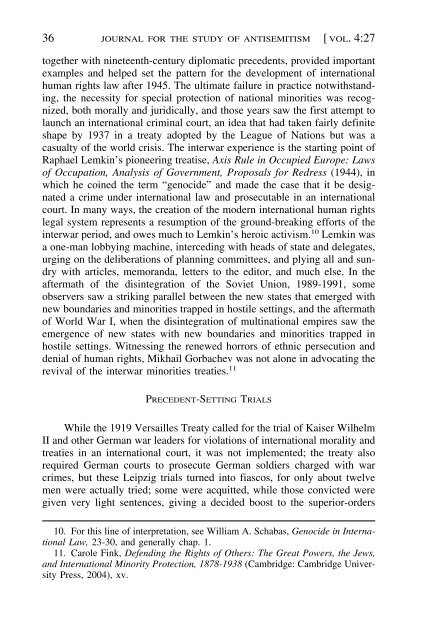Volume 4 No 1 - Journal for the Study of Antisemitism
Volume 4 No 1 - Journal for the Study of Antisemitism
Volume 4 No 1 - Journal for the Study of Antisemitism
You also want an ePaper? Increase the reach of your titles
YUMPU automatically turns print PDFs into web optimized ePapers that Google loves.
36 JOURNAL FOR THE STUDY OF ANTISEMITISM [ VOL. 4:27<br />
toge<strong>the</strong>r with nineteenth-century diplomatic precedents, provided important<br />
examples and helped set <strong>the</strong> pattern <strong>for</strong> <strong>the</strong> development <strong>of</strong> international<br />
human rights law after 1945. The ultimate failure in practice notwithstanding,<br />
<strong>the</strong> necessity <strong>for</strong> special protection <strong>of</strong> national minorities was recognized,<br />
both morally and juridically, and those years saw <strong>the</strong> first attempt to<br />
launch an international criminal court, an idea that had taken fairly definite<br />
shape by 1937 in a treaty adopted by <strong>the</strong> League <strong>of</strong> Nations but was a<br />
casualty <strong>of</strong> <strong>the</strong> world crisis. The interwar experience is <strong>the</strong> starting point <strong>of</strong><br />
Raphael Lemkin’s pioneering treatise, Axis Rule in Occupied Europe: Laws<br />
<strong>of</strong> Occupation, Analysis <strong>of</strong> Government, Proposals <strong>for</strong> Redress (1944), in<br />
which he coined <strong>the</strong> term “genocide” and made <strong>the</strong> case that it be designated<br />
a crime under international law and prosecutable in an international<br />
court. In many ways, <strong>the</strong> creation <strong>of</strong> <strong>the</strong> modern international human rights<br />
legal system represents a resumption <strong>of</strong> <strong>the</strong> ground-breaking ef<strong>for</strong>ts <strong>of</strong> <strong>the</strong><br />
interwar period, and owes much to Lemkin’s heroic activism. 10 Lemkin was<br />
a one-man lobbying machine, interceding with heads <strong>of</strong> state and delegates,<br />
urging on <strong>the</strong> deliberations <strong>of</strong> planning committees, and plying all and sundry<br />
with articles, memoranda, letters to <strong>the</strong> editor, and much else. In <strong>the</strong><br />
aftermath <strong>of</strong> <strong>the</strong> disintegration <strong>of</strong> <strong>the</strong> Soviet Union, 1989-1991, some<br />
observers saw a striking parallel between <strong>the</strong> new states that emerged with<br />
new boundaries and minorities trapped in hostile settings, and <strong>the</strong> aftermath<br />
<strong>of</strong> World War I, when <strong>the</strong> disintegration <strong>of</strong> multinational empires saw <strong>the</strong><br />
emergence <strong>of</strong> new states with new boundaries and minorities trapped in<br />
hostile settings. Witnessing <strong>the</strong> renewed horrors <strong>of</strong> ethnic persecution and<br />
denial <strong>of</strong> human rights, Mikhail Gorbachev was not alone in advocating <strong>the</strong><br />
revival <strong>of</strong> <strong>the</strong> interwar minorities treaties. 11<br />
PRECEDENT-SETTING TRIALS<br />
While <strong>the</strong> 1919 Versailles Treaty called <strong>for</strong> <strong>the</strong> trial <strong>of</strong> Kaiser Wilhelm<br />
II and o<strong>the</strong>r German war leaders <strong>for</strong> violations <strong>of</strong> international morality and<br />
treaties in an international court, it was not implemented; <strong>the</strong> treaty also<br />
required German courts to prosecute German soldiers charged with war<br />
crimes, but <strong>the</strong>se Leipzig trials turned into fiascos, <strong>for</strong> only about twelve<br />
men were actually tried; some were acquitted, while those convicted were<br />
given very light sentences, giving a decided boost to <strong>the</strong> superior-orders<br />
10. For this line <strong>of</strong> interpretation, see William A. Schabas, Genocide in International<br />
Law, 23-30, and generally chap. 1.<br />
11. Carole Fink, Defending <strong>the</strong> Rights <strong>of</strong> O<strong>the</strong>rs: The Great Powers, <strong>the</strong> Jews,<br />
and International Minority Protection, 1878-1938 (Cambridge: Cambridge University<br />
Press, 2004), xv.














